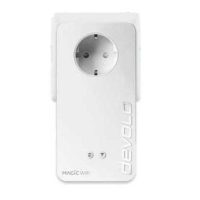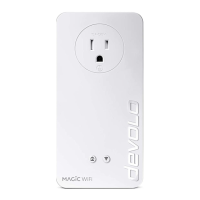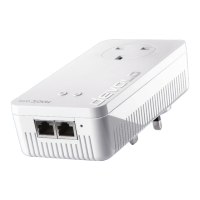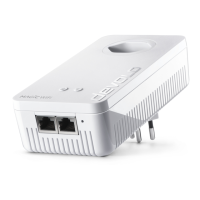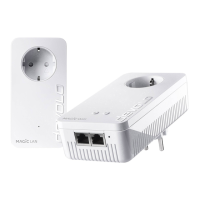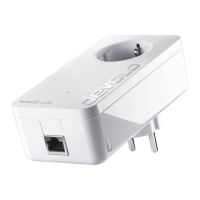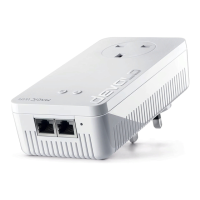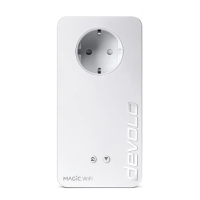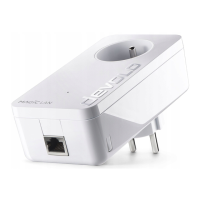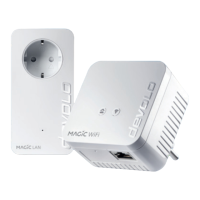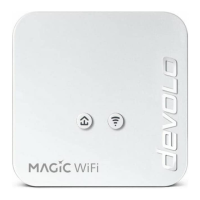
Do you have a question about the Devolo Magic 1 WiFi mini and is the answer not in the manual?
| Modulation | 64-QAM, 256-QAM, 1024-QAM, 4096-QAM, BPSK, DSSS, OFDM, QPSK |
|---|---|
| Power plug | Type C |
| Ethernet LAN | Yes |
| Wi-Fi standards | 802.11b, 802.11g, Wi-Fi 4 (802.11n) |
| Top Wi-Fi standard | Wi-Fi 4 (802.11n) |
| Security algorithms | 128-bit AES, WPA, WPA2, WPS, WPS-PBC, WPS-PIN |
| Networking standards | IEEE 802.11b, IEEE 802.11g, IEEE 802.11n, IEEE 802.1p, IEEE 802.3, IEEE 802.3az, IEEE 802.3u, IEEE 802.3x |
| Built-in power socket | No |
| Ethernet LAN data rates | 10, 100 Mbit/s |
| Ethernet LAN (RJ-45) ports | 1 |
| Maximum data transfer rate | 1200 Mbit/s |
| Maximum operating distance | 400 m |
| Ethernet LAN interface type | Fast Ethernet |
| Copper ethernet cabling technology | 10BASE-T, 100BASE-TX |
| WLAN data transfer rates supported | 300 Mbit/s |
| Certification | CE |
| Product color | White |
| LED indicators | PLC, WLAN |
| Cables included | LAN (RJ-45) |
| Quantity per pack | - pc(s) |
| AC input voltage | 196 - 250 V |
| AC input frequency | 50 Hz |
| Power consumption (standby) | 1 W |
| Power consumption (typical) | 4.4 W |
| Storage temperature (T-T) | -25 - 70 °C |
| Operating temperature (T-T) | 0 - 40 °C |
| Operating relative humidity (H-H) | 10 - 90 % |
| Mac operating systems supported | Mac OS X 10.10 Yosemite, Mac OS X 10.11 El Capitan, Mac OS X 10.12 Sierra, Mac OS X 10.13 High Sierra, Mac OS X 10.14 Mojave, Mac OS X 10.15 Catalina, Mac OS X 10.9 Mavericks |
| Linux operating systems supported | Ubuntu 16.04, Ubuntu 16.10, Ubuntu 17.10 |
| Mobile operating systems supported | Android 5.1, Android 6.0, Android 7.0, Android 7.1, Android 7.1.2, Android 8.0, Android 9.0, iOS 10.0, iOS 11.0, iOS 11.4, iOS 12, iOS 13 |
| Windows operating systems supported | Windows 10, Windows 10 IOT Core, Windows 10 Pro, Windows 10 Pro x64, Windows 10 x64, Windows 7, Windows 7 Professional x64, Windows 7 Starter, Windows 7 Starter x64, Windows 7 Ultimate, Windows 7 Ultimate x64, Windows 8 |
| Harmonized System (HS) code | 85171800 |
| Depth | 41 mm |
|---|---|
| Width | 68 mm |
| Package depth | 231 mm |
| Package width | 190 mm |
| Package height | 92 mm |
| Package weight | 670 g |
Provides guidance on reading the manual and explains the meaning of various icons used.
Details proper indoor usage of devolo products and their function as home network devices.
Advises on using approved software, provided accessories, and accessing online resources for support.
Covers product compliance with EU directives and essential safety instructions for device operation.
Warns about heat development and directs users to the devolo website for information and support.
Introduces devolo Magic technology for enhancing home multimedia capabilities with improved speed and stability.
Details Magic adapter features including Powerline, Mesh Wi-Fi, and advanced functions.
Highlights PowerSave mode and the function of the network connector for device connectivity.
Lists key hardware features of the Magic 1 WiFi mini, including buttons, antennas, and ports.
Explains pairing devolo Magic adapters to establish Powerline connections for new and expanded networks.
Details different LED behaviors on the Powerline indicator for status updates.
Describes Wi-Fi button functions, including toggling Wi-Fi and activating WPS.
Guides on connecting Wi-Fi devices via WPS (Wi-Fi Protected Setup) using the Wi-Fi button.
Explains Wi-Fi LED states indicating Wi-Fi status, WPS mode, or disabled function.
Details reset button functions and the network jack for wired connections.
Lists kit contents and system requirements for devolo Cockpit and network setup.
Provides instructions for connecting and integrating the Magic 1 WiFi mini into a network.
Guides through the automatic setup of a new Powerline network using the Starter Kit.
Explains adding adapters and changing the network password for security.
Guides Wi-Fi connection setup, WiFi Clone, and devolo Cockpit software installation.
Covers downloading the devolo app and removing adapters from a PLC network.
Explains accessing the web interface and provides an overview of its menu structure and login.
Covers login, language selection, saving/canceling changes, and interface elements.
Explains interface help text, settings types, tables, error handling, and button functions.
Provides an overview of system, Wi-Fi, and Powerline status information for the device.
Details LAN status and IP configuration for cable-based networks.
Introduces the Wi-Fi area for making wireless network changes and viewing status details.
Guides on changing Wi-Fi network mode, name, channel, and encryption settings.
Details SSID hiding and Wi-Fi security standards like WPA3 for wireless networks.
Guides on setting up a separate guest network for visitor Internet access and its configuration.
Covers guest network details and introduces Mesh Wi-Fi features like fast roaming.
Explains Mesh functionality for optimizing Wi-Fi experience with features like fast roaming and air-time fairness.
Describes the Wi-Fi Clone function for copying Wi-Fi configuration data to other access points.
Explains how to schedule Wi-Fi on/off times and configure convenience functions.
Guides on regulating Wi-Fi access for specific devices based on time, with parental control features.
Details configuring parental control by MAC address and defining access time periods.
Explains how to set time quotas and specific time periods for Wi-Fi access.
Introduces WPS for secure wireless network setup and enabling WPS encryption.
Details using WPS pushbutton and PIN methods for transmitting encryption keys.
Describes the display of visible wireless networks in the surroundings.
Covers forming networks, assigning passwords, and compatibility modes for Powerline connections.
Details pairing, custom passwords, and unpairing adapters from Powerline networks.
Discusses compatibility modes and lists connection details for Powerline adapters.
Covers LAN status and IPv4/IPv6 configuration for IP address assignment.
Guides on IPv6 configuration for automatic or static IP address assignment.
Explains viewing system status and managing device information, including password protection.
Details Power-save, Standby modes, LEDs, buttons, and time settings.
Covers saving, restoring, and resetting device configurations, and rebooting the device.
Details checking current firmware, downloading updates, and the automatic update process.
Describes Config Sync for uniform configuration of Wi-Fi, Guest, and Mesh settings across network devices.
Lists technical specs and provides optimization tips for network transmission capacity.
Details technical specifications for the 2.4-GHz frequency range, including standards and power.
Lists channels/frequencies and explains proper disposal of old electronic devices.
Provides information on warranty conditions and vendor contact for claims.
